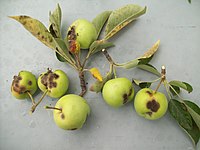
Photo from wikipedia
Bitter rot is a major disease of apple fruit in warm and humid regions. It is caused by various species in the Colletotrichum gloeosporioides and C. acutatum species complexes, of… Click to show full abstract
Bitter rot is a major disease of apple fruit in warm and humid regions. It is caused by various species in the Colletotrichum gloeosporioides and C. acutatum species complexes, of which C. fioriniae of the C. acutatum species complex is most common in the Mid-Atlantic region of the United States. While bitter rot management begins with good cultural practices, fungicides are generally used for consistent control. Fungicides should be applied before or during infection periods, but the timing of infection is unclear due to the hemibiotrophic lifestyle of the causal species. To determine when infection periods occur, we quantified C. fioriniae spore dispersal throughout three growing seasons and compared the temporal susceptibility of apples in two seasons of field trials. Spores were detected in rainwater from bud break to leaf drop, with the highest spore quantities in the summer and early fall correlating with optimal temperatures for C. fioriniae. Late-season-inoculated fruit had more bitter rot than early-season-inoculated fruit, but this was also positively correlated with periods of optimal temperatures and moisture for infection. In the context of previous experiments, these results suggest that infection periods are primarily determined by temperature and moisture rather than apple fruit phenology. Based on the relative numbers of spores, biotrophic and necrotrophic infections, only a tiny proportion of spores establish viable biotrophic infections, but a relatively high proportion of biotrophic infections switch to necrotrophy. We suggest bitter rot management should focus on preventing initial biotrophic infections by protecting apples during weather conditions that favor infection.
Journal Title: Plant disease
Year Published: 2023
Link to full text (if available)
Share on Social Media: Sign Up to like & get
recommendations!